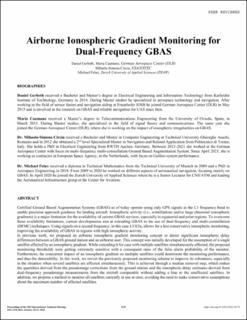Bitte benutzen Sie diese Kennung, um auf die Ressource zu verweisen:
https://doi.org/10.21256/zhaw-24614| Publikationstyp: | Konferenz: Paper |
| Art der Begutachtung: | Peer review (Publikation) |
| Titel: | Airborne ionospheric gradient monitoring for dual-frequency GBAS |
| Autor/-in: | Gerbeth, Daniel Caamano, Maria Circiu, Mihaela-Simona Felux, Michael |
| et. al: | No |
| DOI: | 10.33012/2022.18179 10.21256/zhaw-24614 |
| Tagungsband: | Proceedings of the 2022 International Technical Meeting of The Institute of Navigation |
| Seite(n): | 1110 |
| Seiten bis: | 1122 |
| Angaben zur Konferenz: | International Technical Meeting of the Institute of Navigation (ION ITM), Long Beach, USA, 25-27 January 2022 |
| Erscheinungsdatum: | Jan-2022 |
| Verlag / Hrsg. Institution: | Institute of Navigation |
| Verlag / Hrsg. Institution: | Manassas |
| ISBN: | 978-0-936406-30-5 |
| ISSN: | 2330-3646 |
| Sprache: | Englisch |
| Schlagwörter: | GBAS; GNSS; Ionosphere; Ionospheric gradient monitoring |
| Fachgebiet (DDC): | 629: Luftfahrt- und Fahrzeugtechnik |
| Zusammenfassung: | Certified Ground Based Augmentation Systems (GBAS) as of today operate using only GPS signals in the L1 frequency band to enable precision approach guidance for landing aircraft. Ionospheric activity (i.e., scintillations and/or large abnormal ionospheric gradients) is a major limitation for the availability of current GBAS services, especially in equatorial and polar regions. To overcome these availability limitations, current developments aim at extending GBAS to the use of dual-frequency and multi-constellation (DFMC) techniques. Using signals on a second frequency, in this case L5/E5a, allows for a less conservative ionospheric monitoring, improving the availability of GBAS in regions with high ionospheric activity. In previous work, we proposed an airborne ionospheric gradient monitoring concept to detect significant ionospheric delay differences between a GBAS ground station and an airborne user. This concept was initially developed for the assumption of a single satellite affected by an ionospheric gradient. While extending it for case with multiple satellites simultaneously affected, the proposed monitoring thresholds were getting extremely sensitive with a consequent raise of the false alarm probability of the monitor. Furthermore, the concurrent impact of an ionospheric gradient on multiple satellites could deteriorate the monitoring performance, and thus the detectability. In this work, we revisit the previously proposed monitoring scheme to improve its robustness, especially in the situation when several satellites are affected simultaneously. This is achieved through a median removal step, which makes the quantities derived from the pseudorange corrections from the ground station and the ionospheric delay estimates derived from dual-frequency pseudorange measurements from the aircraft comparable without adding a bias to the unaffected satellites. In addition, we propose a method to monitor all satellites currently in use at once, avoiding the need to make conservative assumptions about the maximum number of affected satellites. |
| URI: | https://digitalcollection.zhaw.ch/handle/11475/24614 |
| Volltext Version: | Publizierte Version |
| Lizenz (gemäss Verlagsvertrag): | Lizenz gemäss Verlagsvertrag |
| Gesperrt bis: | 2022-08-01 |
| Departement: | School of Engineering |
| Organisationseinheit: | Zentrum für Aviatik (ZAV) |
| Enthalten in den Sammlungen: | Publikationen School of Engineering |
Dateien zu dieser Ressource:
| Datei | Beschreibung | Größe | Format | |
|---|---|---|---|---|
| 2022_Gerbeth-etal_Airborne-ionospheric-gradient-monitoring.pdf | 965.63 kB | Adobe PDF |  Öffnen/Anzeigen |
Zur Langanzeige
Gerbeth, D., Caamano, M., Circiu, M.-S., & Felux, M. (2022). Airborne ionospheric gradient monitoring for dual-frequency GBAS [Conference paper]. Proceedings of the 2022 International Technical Meeting of the Institute of Navigation, 1110–1122. https://doi.org/10.33012/2022.18179
Gerbeth, D. et al. (2022) ‘Airborne ionospheric gradient monitoring for dual-frequency GBAS’, in Proceedings of the 2022 International Technical Meeting of The Institute of Navigation. Manassas: Institute of Navigation, pp. 1110–1122. Available at: https://doi.org/10.33012/2022.18179.
D. Gerbeth, M. Caamano, M.-S. Circiu, and M. Felux, “Airborne ionospheric gradient monitoring for dual-frequency GBAS,” in Proceedings of the 2022 International Technical Meeting of The Institute of Navigation, Jan. 2022, pp. 1110–1122. doi: 10.33012/2022.18179.
GERBETH, Daniel, Maria CAAMANO, Mihaela-Simona CIRCIU und Michael FELUX, 2022. Airborne ionospheric gradient monitoring for dual-frequency GBAS. In: Proceedings of the 2022 International Technical Meeting of The Institute of Navigation. Conference paper. Manassas: Institute of Navigation. Januar 2022. S. 1110–1122. ISBN 978-0-936406-30-5
Gerbeth, Daniel, Maria Caamano, Mihaela-Simona Circiu, and Michael Felux. 2022. “Airborne Ionospheric Gradient Monitoring for Dual-Frequency GBAS.” Conference paper. In Proceedings of the 2022 International Technical Meeting of the Institute of Navigation, 1110–22. Manassas: Institute of Navigation. https://doi.org/10.33012/2022.18179.
Gerbeth, Daniel, et al. “Airborne Ionospheric Gradient Monitoring for Dual-Frequency GBAS.” Proceedings of the 2022 International Technical Meeting of the Institute of Navigation, Institute of Navigation, 2022, pp. 1110–22, https://doi.org/10.33012/2022.18179.
Alle Ressourcen in diesem Repository sind urheberrechtlich geschützt, soweit nicht anderweitig angezeigt.